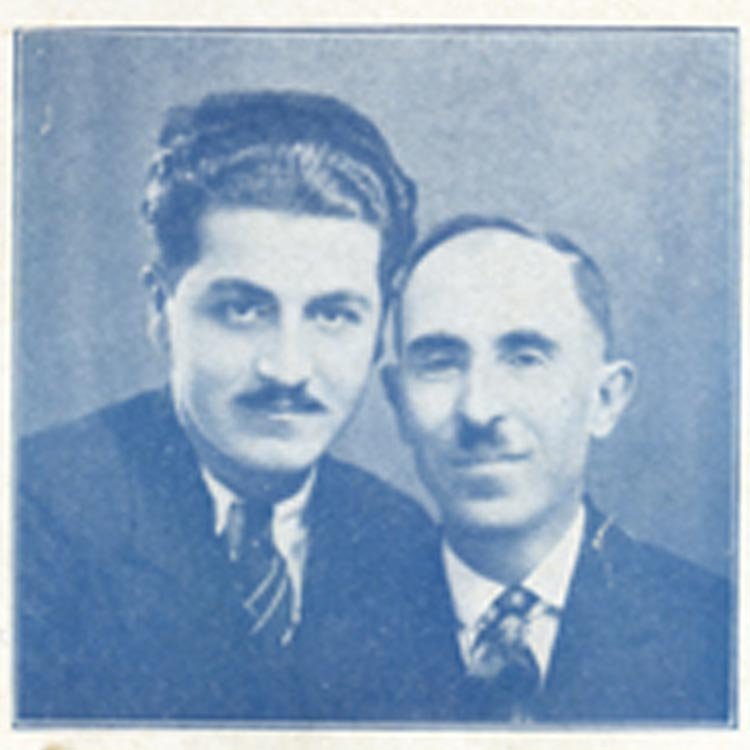Like Father, Like Son: The Joyful Music of Stepan and Haigaz Simonian
Written by Jesse Kenas Collins
Stepan & Haigaz Simonian
Born: Mezire, Kharpert, 1887 & Worcester, MA, 1909 (respectively)
Died: Worcester, MA, 1929 & Belmont, MA, 1998 (respectively)
Active years recording: 1920s
Label association: Columbia Records, Pharos Records
Among the numerous musicians from the Kharpert region that recorded for Columbia Records in the 1920s, the father and son duo Stepan and Haigaz Simonian stand out for their exuberant renditions of regional dances. Stepan Simonian was born in 1887 in Mezire and came to the United States in 1907, settling first in Haverhill, then later in Worcester, MA, where he worked as a cobbler. He and his wife Sophia Berberian, a Kharpert Assyrian, had two sons and two daughters. Their oldest son and Stepan’s collaborator, Haigaz, was born in 1909 in Worcester.
Stepan was a violin player and singer well versed in the folk songs of his native Kharpert and brought Haigaz up as a multi-instrumentalist within this tradition. When the duo recorded for Columbia records in 1927 they stayed true to the form, presenting songs predominantly in the unique time signatures characteristic of Kharpert. Though deeply traditional in their performance, the group breaks from traditional instrumentation with Haigaz on piano alongside Stepan leading the melody on violin.
Featured here are three songs that the group recorded for Columbia Records at the label’s New York studios in November of 1927. "Haigagan Makam" is a medley of the well known folk songs "Mer Khntzorin Dzar" (Our Apple Tree) played in a 10/8 rhythm while "Hoy Nazan Im Yaruh" (Hey My Coy Darling) is played in a 2/4 rhythm. Starting in medium 10/8 and moving to a quick 2/4 is an extremely common practice of Western Armenian folk orchestras to this day but rarely demonstrated on early recordings, possibly because those records were not necessarily representative of how a set was played at a live dance or event. Worcester resident and cobbler, Shmon Arslen appears on the other side of these records as a singer accompanied by Stepan and Haigaz; he is also possibly the dumbeg player on the songs featured here. In addition to the recordings for Columbia, Stepan and Haigaz appeared on the Pharos label in the 1920’s in collaboration with Vartan Margosian, a folk singer and violin player from Kharpert (see our recent post on Margosian here).
Portrait of Stepan and Haigaz Simonian featured in Pharos Records catalog circa 1920s (scan: from the collection of the Armenian Museum of America)
Sadly Stepan passed away in 1929 at the young age of 42. Haigaz became a long-time resident of Belmont and was known locally as Henry Simmons. With Armenian music being so deeply rooted as a part of his life, he went on to perform extensively in the Boston area well into the 1980s. Has was a member of the Hye-Echoes Ensemble, appearing on the band's 1983 album Mer Avantoutiunuh. In addition to his musical activities, Henry was a florist by trade, having established in 1946 one of the first schools of floral design in the country. He went on to operate his own shop, Flowers by Simmon in Wellesley, MA until 1978. Many in the Watertown area may remember him from Cass Florist where he worked in his later years. Henry passed away in 1998 leaving behind the musical legacy he inherited from his father and nurtured throughout his lifetime.
In addition to copies of the Pharos and Columbia recordings, the Museum is fortunate to have in its collection several photographs and musical instruments belonging to Henry which were graciously donated by his daughter, Nancy Simmons. The instruments include his violin, kanun, and dumbeg, the last of which is currently on view in our galleries. To hear Collections Curator Gary Lind-Sinanian discuss the dumbeg and other instruments on display, see the video Treasures from Our Collection: Oud & Dumbeg. Below is an image from the Museum’s collection showing Henry with his dumbeg, his face expressing the same abundant joy and exuberance heard on the recordings presented here.
Portrait of Haigaz Simonian playing the dumbeg (Photograph: from the collection of the Armenian Museum of America - donated by Nancy Simmons)
A special thanks to the SJS Charitable Trust for their generous support of our work to digitize and share our collection of 78 rpm records.
Jesse Kenas Collins has been instrumental in the digitization of our collection of 78 rpm records, and Harry Kezelian and Harout Arakelian’s contributions of research and consultation have been critical to assembling the writings presented over the past year. We’d also like to thank Collections Curator Gary Lind-Sinanian for his stewardship of this collection, and to the donors who have entrusted the Museum with these records.



